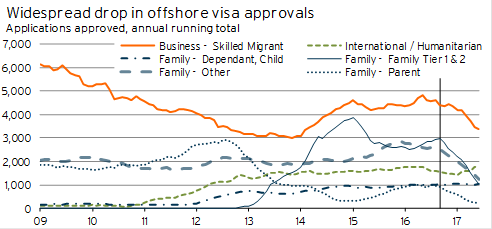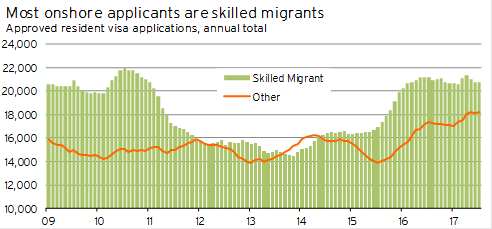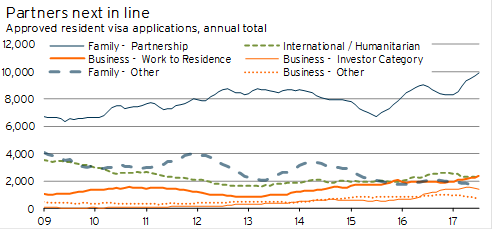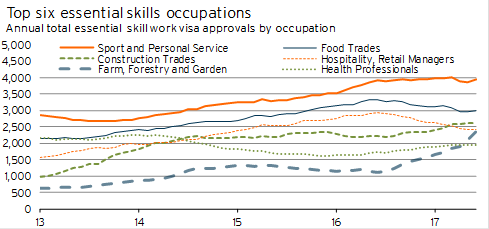Will government rule changes have a big effect on visa approvals?
The government has been successively tightening the rules for resident visas since October 2016. The purpose of these rule changes ostensibly is to reduce the number of people moving to New Zealand while not cutting off the supply of workers for our overstretched labour market. But each set of rule changes will have very different effects for migrants on work and resident visas. In this article, we outline the rule changes and discuss the implications of these changes for migration numbers and industry stakeholders.
October 2016 rule changes
- Parents are no longer able to get resident visas via their child’s visas – they must obtain the visa in their own right.
- Families : there is a quota on the number of people that can move to New Zealand under the capped family visa category. In October 2016, this quota was reduced from 5,500pa to 2,000pa for the June 2017 and 2018 years.
- Points requirements for skilled migrant applicants were lifted. Skilled migrant visas are a subset of the resident visa category.
April 2017 rule changes
To be implemented August 28.
Applicants for residency under the skilled migrant category
- The government proposed that skilled migrant applicants must prove a salary of over $49,000pa.
- There are two other remuneration thresholds affecting potential skilled migrants : an annual salary of $73,299 will put a migrant up for consideration as a skilled migrant even if they don’t fit in an accepted skill level category. An annual salary equal to or over $97,718 will gain an applicant bonus points for a skilled migrant resident visa [1] .
- More points will be awarded for work experience and education , particularly skilled work experience in New Zealand and in ANZSCO skill level 1, 2, and 3 occupations. Migrants with masters and doctorate degrees have access to more points, but points for their partners will be determined by their partner’s own level of education.
- People in the 30-39 year age group will have access to more points.
- Spouses and children of skilled migrants no longer automatically receive work or student visas because their partner/parent is a skilled migrant. They must apply and be approved in their own right; otherwise they can come to New Zealand as visitors for three months.
Other (mostly work visa-related) policy changes
- Pay band-related regulation has also been announced for Essential Skills work visas. Migrants earning under 85% of the median New Zealand income (currently $41,538), will be classified as “lower-skilled” and subject to a 12-month stand-down period after three years. Migrants earning more can remain in New Zealand on an essential skills work visas if they earn between $41,538 and $73,299 and work in an ANZSCO level 1-3 occupation or if they earn above $73,299.
- Seasonal workers will only be able to stay in New Zealand on their work visa for the duration of their work, rather than the full year.
- A total of 4000 South Island temporary (work) migrants have been given the option to gain residency if they stay in their region and industry for the next two years.
October 2016 rule changes have already affected offshore approvals
Most of last October’s rule changes were targeted at family resident visa categories. Since then, there has been a sharp drop in offshore visa approvals across all family visa categories except dependent children. This drop-off will stabilise by October next year, with future declines under these rule changes unlikely.
Graph 12

Prior to the rule change last October, a tailing-off in skilled migrant visa approval numbers was already occurring. The increase in points requirements for skilled migrants will only just be starting to affect skilled migrant approval numbers now. Due to the procedure for applying for resident visas, the people that had already been invited to apply for residency before October will not have been rejected on the basis of the change in points requirements. It is unknown as to why offshore applications for skilled migrant visas was already declining before the rule changes were introduced .
April 2017 rule changes target the biggest category of resident visa applicants
Skilled migrants are the biggest subcategory of both onshore and offshore visa applications, but 86% of skilled migrants apply from within New Zealand. Skilled migrants made up half of all resident visa approvals in the year to June 2016 and are the main target of the April 2017 rule changes.
Graph 13

The second-biggest contributor to onshore applications, and less than half the size of skilled migrant applications, is people coming here on partnership visas. Over the year to June 2017, 9,919 people were approved for partnership visas to be residents in New Zealand. The effect of resident visa rule changes will have no direct effect on the partnership visa count, but if fewer people are approved for skilled migrant visas, it is likely that fewer people will be eligible for the associated partnership visas.
Graph 14

There has been a gradual lift in work-to-resident visa approvals since 2013, but the April rule changes do not tighten restrictions for workers using this pathway to residency.
Which industries are most affected by the changes to work visa rules?
The number of people arriving on work visas has climbed steadily since late 2010. In the year to June 2017, the number of people arriving on work visas was up 10% from a year earlier. But the rule changes around temporary migrant visas only affect those in the Essential Skills category (as opposed to those on working holiday visas, who presumably make up most of the people that leave New Zealand within 12 months ). Essential Skills visa applicants made up 15% of all work visa approvals over the year to June 2017.
Essential Skills work visas currently allow workers to live and work in New Zealand for up to three years, with the option to reapply for the same visa at the end of the period. The rule changes proposed in April require those earning under $41,538, or earning under $73,299 in an occupation not classed as being ANZSCO level 1-3 (a measure of skills), will face a stand-down period of 12 months before they can reapply for a new work visa.
Breaking Essential Skills work visa approvals down by occupation suggests that the sport and personal services sector is most exposed to the April rule changes, followed by the hospitality and food industry. Given the high proportion of people on work visas whose occupations are in low-paying industries such as hospitality and personal services, the new income thresholds could affect thousands of applicants if they are hoping to stay in New Zealand on work visas for more than three years.
Graph 15

According to Immigration NZ, between 38% and 46% of Essential Skill visa holders will be classified as “lower-skilled” purely on the basis of their low salaries. These figures equate to 9,700-11,800 people here on Essential Skill work visas. In addition, just over 11,000 people do not even have the qualifications to hold their Essential Skills visa for more than three years, except the few that earn above $73,299pa.
We know that only two-thirds of people arriving on work visas stay for more than a year, suggesting that some firms are used to training new staff on an ongoing basis. However, the three-year time limit poses an ultimatum for business owners regarding migrants on work visas – either train them to a skill level justifying a $41,538pa salary or be prepared to let staff go within three years. As remuneration can differ regionally and across occupations, this salary restriction may curb some of the foreign labour supply to regions and direct more migrants to the cities where they are better able to obtain higher-paying jobs. Minimum salary requirements may also raise the overall cost of employing workers in some areas, encouraging employers to adopt increased automation to achieve growth in output and boost worker productivity.
But there is significant backlash from industry stakeholders
The October 2016 rule changes affect a small group of resident visa applicants and, as a result, were met with very little complaint. In contrast, April’s proposed rule changes apply to a large proportion of resident and work visa applicants and have attracted significant backlash from industry stakeholders.
Stakeholders have argued that the minimum salary requirement is a blunt instrument that would disproportionately hamper labour-starved regions. In terms of temporary work visas, the minimum salary requirement is determined by the median New Zealand income. But average salaries in provincial areas are typically below the nationwide median, while urban areas tend to offer higher-paying jobs. Where a region sits relative to this 85% of the median income line will affect the flow of migrant labour into these areas.
Although we agree that high skilled remuneration bands better acknowledge high value-adding workers, we think that the salary-based definition for low-skilled work might create unwanted ructions in the New Zealand labour market. At the same time, it is difficult to offer alternative policy solutions in this case, with area-based salary requirements likely to be an administrative headache.
We recommend that the government reconsiders implementing its lowest remuneration band for work visas, but retain the remuneration bands for skilled migrant residency applications. Retaining salary restrictions around resident visas is still blunt, but represents a minimum skills requirement for people intending to remain in New Zealand long term. The idea behind this policy is that the more skills you have, the more you can contribute to New Zealand’s productive output, and that you are less at risk of unemployment.
In contrast, work visas should remain an option for people staying temporarily in New Zealand, with minimum skill or income requirements being less important. People in New Zealand on work visas will tend to stay only as long as there is work available, regardless of the region.
In most people coming from Australia are Kiwi, we discuss the effects that the migrants we can’t control (New Zealanders and Australians) have on net migration.
In migration levels we should be targeting we discuss how the the government should target net migration as a whole.
All these articles are part of an in-depth report on migration. Please find the full report here.
1 Remuneration thresholds will be updated annually based on New Zealand income data.

























